![]()
![]()
![]()
Use LEFT and RIGHT arrow keys to navigate between flashcards;
Use UP and DOWN arrow keys to flip the card;
H to show hint;
A reads text to speech;
82 Cards in this Set
- Front
- Back
- 3rd side (hint)
|
Behavioral Genetics
|
the study of the relative effects of heredity and tge environment of behavior and mental processes
|
|
|
|
Evolutionary Psychology
|
the brach of psychology that studies the application of the principles of evolution to expalin behavior and mental processes
|
|
|
|
Gene
|
a segment of DNA (deoxyribonucleic acid) that occupies a specific place on a particualr chromosome and caries the code for hereditary transmission
|
|
|
|
Dominant Gene
|
reveals its trait whenever the gene is present
|
|
|
|
Recessive Gene
|
normally expressed only if the other gene in the pair is also recessive
|
|
|
|
Polygenic
|
controlled by multiple genes
|
|
|
|
Heritability
|
a statistical formula that provides a percantage of variation in a population attributable to genetic factors rather than to differences in the environment
-heritability estimates do not apply to individuals -does not trump environment |
|
|
|
Natural Selection
|
the process by which heritable traits that increase an organism's chances of survival or reproduction are favored over less beneficial traits
|
|
|
|
Genetic Mutations
|
-changes from the original
can help explain behavior |
|
|
|
Key Parts of a Neuron
|
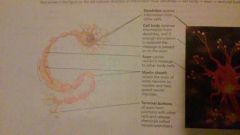
|
|
|
|
Neuron
|
the basic building block (nerve cell) of the nervous system, responsible for receiving, processing, and transmitting electrochemical information
|
|
|
|
Glial Cells
|
the cells that provide structural, nutritional, and other support for neurons, as well as communications within the nervous system; also called glia or neuroglia
|
|
|
|
Dendrites
|
the branching fibers of neurons that receive neural impulses from other neurons and convey impulses toward the cell body
|
|
|
|
Cell Body
|
the part of a neuron that contains the cell nucleus and other structures that help the neuron carry out its functions, also known as the soma
|
|
|
|
Axon
|
a long, tube-like structure that conveys impulses away from a neuron's cell body toward other neurons or to muscles or glands
|
|
|
|
Action Potential
|
a neural impulse, or brief electrical charge, that carries information along the axon of a neuron; movement is generated when positively charged ions move in and out through channels in the axon's membrane
|
|
|
|
Myelin Sheath
|
covers the axon of some neurons to insulate and help speed neural impulses
|
|
|
|
Terminal Buttons
|
of axon forms junctions with other cells and release chemicals called neurotransmitters
|
|
|
|
Periodic Nodes
|
points at which the myelin is very thin or absent
|
|
|
|
Communication Between Neurons
|
- within the neurons messages travel electrically
- between neurons, messages are transmitted chemically |
|
|
|
Neurotransmitter
|
a chemical messenger released by neurons that travels across the synapse and allows neurons to communicate with one another
|
|
|
|
Agonistic drug
|
a substance that mimics and enhances a neurotransmitter's effect
|
|
|
|
Antagonistic Drug
|
a substance that blocks normal neurotransmitter functioning
|
|
|
|
Acetylcholine (ACh)
|
muscle action, learning, memory, REM(rapid-eye-movement) sleep, emotion; decresed ACh plays a suspected role in Alzheimer's disease
|
|
|
|
Dopamine(DA)
|
movement, atttention, memory, learning, and emotion; excess DA associated with schizophrenia; too little DA linked with Parkinson's disease; also plays role with addiction and the reward system
|
|
|
|
Endorphins
|
a chemical substance in the nervous system similar in structure and action to opiates: mood, pain, memory, learning, blood pressure, appetite, and sexual activity
|
|
|
|
Central Nervous System (CNS)
|
the part of the nervous system consisting of the brain and spinal cord
-makes us able to adapt to our environment |
|
|
|
Peripheral Nervous System (PNS)
|
the part of the nervous system composed of the nerves and neurons connecting the central nervous system (CNS) to the rest of the body
|
|
|
|
Neuroplasticity
|
the brains ability to reorganize and change its structure and function throughout the life span
|
|
|
|
Neurogenesis
|
the process by which new neurons are generated
|
|
|
|
Stem Cells
|
Inmature (uncommitted) cells that have the potential to develop into almost any type of cell, depending on the chemical signals they receive
-hopes for patienst with strokes, Alzheimer's, Parkinson's, epilepsy, stress, and depression |
|
|
|
Reflex
|
an innate, automatic response to a stimulus that has a biological relevance for an organism
-knee-jerk reflex |
|
|
|
Peripheral Nervous System (SNS)
|
carry information to and from central nervous system (CNS). It links the brain and spinal cord to the body's sense receptors, muscles, and glands
-pheripheral (outside) |
|
|
|
Somatic Nervous System (SNS)
|
a subdivision of the peripheral nervous system (PNS) that connects the central nervous system (CNS) to sensory receptors and controls skeletal muscles
|
|
|
|
Autonomic Nervous System (ANS)
|
the subdivision of the pheripheral nervous system (PNS) that controls the body's involuntary motor response by connecting the sensory receptors to the central nervous system (CNS) and the CNS to the smooth muscle, cardiac muscle, and glands
|
|
|
|
Sympathetic Nervous System
|
the subdivision of the autonomic nervous system (ANS) that is responsible for arousing the body and mobilizing its energy during times of stress; also called the "fight-or-flight" system
|
|
|
|
Parasympathetic Nervous System
|
the subdivision of the autonomic nervous system (ANS) that is responsible for calming the body and conserving energy
-provides adaptive, evolutionary advantage |
|
|
|
Lesioning Techniques
|
systematically destroying brain tissue to study the effects on behavior and mental processes
|
|
|
|
Noninvasive
|
method use that does not involve breaking the skin or entering the body
|
|
|
|
Localization of Function
|
certain brain structures are specialized to perform certain tasks
|
|
|
|
The Human Brain
|
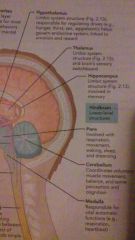
|
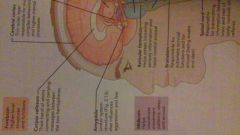
|
|
|
Hindbrain
|
the lower or hind region of the brain; collection of structures including teh medulla, pons, and cerebellum
|
|
|
|
Medulla
|
the hindbrain structure responsible for vital, automatic functions, such as respiration and heartbeat
|
|
|
|
Pons
|
the hindbrain structure involved in respiration, movement, waking, sleep, and dreaming
|
|
|
|
Cerebellum
|
the hindbrain structure responsible for coordinating fine muscle movement, balance, and some perception and cognition
|
|
|
|
Midbrain
|
the collection of structures in the middle of the brain responsible for coordinating movement patterns, sleep, and arousal
|
|
|
|
Reticular Formation (RF)
|
the diffuse set of neurons that helps screen incoming information and controls arousal
|
|
|
|
Substantia Nigra
|
-midbrain
a small structure that secretes the neurotransmitter dopamine |
|
|
|
Parkinson's Disease
|
related to the deterioration of neurons in the substantia nigra and the subsequent loss of dopamine
|
|
|
|
Forebrain
|
the collection of upper-level brain structures including the thalamus, hypothalamus, limbic system, and cerebral cortex
|
|
|
|
Thalamus
|
the forebrain structure at the top of the brainstem that serves as the brain's switchboard, relaying sensory messages to the cerebral cortex
-thalamus damage linked to schizophrenia |
|
|
|
Schizophrenia
|
a serious psychological disorder characterized by the problems with sensory filtering and perception
|
|
|
|
Hypothalamus
|
the small brain structure beneath the thalamus that helps govern drives (hunger, thirst, sex, and aggression) and hormones
|
|
|
|
Major Brain Structures Comomly Associated with the Limbic System
|
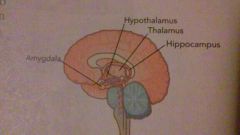
|
|
|
|
Pituitary Gland
|
considered the master endocrine gland because it releases hormones that activate the other endocrien glands
|
|
|
|
Limbic System
|
the interconnected group of forebrain structures involved with emotions, drives, and memory, as well as major physiological functions
|
|
|
|
Hippocampus
|
the sea-horse shaped part of the limbic system involved in forming and retrieving memories
|
|
|
|
Amygdala
|
a part of the limbic system that controls emotions, like aggression and fear, and the formation of emotional memory
|
|
|
|
Cerebral Cortex
|
the thin surface layer on the cerebral hemispheres that regulates most complex behavior, incliding sensations, motor control, and higher mental processes
|
|
|
|
Convolutions
|
the numeral wrinkles of the cerebral cortex that significantly increase its surface area
|
|
|
|
Frontal Lobes
|
the two lobes at the front of the brain that govern motor control, speech production, and higher functions, such as thinking, personality, emotion, and memory
|
|
|
|
fissure
|
the division of the brain that marks the separation between the left and the right hemisphere
|
|
|
|
Motor Cortex
|
an area at the very back of the frontal lobes that instigates all voluntary movement
|
|
|
|
Lobes of the Brain
|
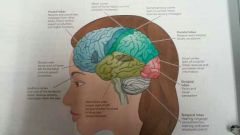
|
|
|
|
Broca's area (lobe)
|
(lower part of lower-left frontal lobe) controls speech production
|
|
|
|
Auditory Cortex
|
(top area of the twmporal lobes) receives sensory informations from the ears
|
|
|
|
Wernicke's Area
|
(upper part of left temporal lobe) involved in language comprehension
|
|
|
|
Somatosensory Cortex
|
(part of the parietal lobes) receives sensory messages
|
|
|
|
Parietal Lobes
|
Lobes located at the top of the brain, in which bodily sensations are received and interpreted
|
|
|
|
Occipital Lobes
|
the two lobes in the back of the brain that are responsible for vision and visual perception
|
|
|
|
Temporal Lobes
|
the two lobes on each side of the brain above the ears that are involved in audition (hearing), language, comprehension, memory, and sone emotional control
|
|
|
|
Phineas Gage
|
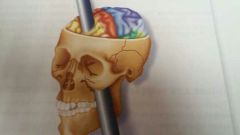
|
|
|
|
Association Areas
|
the "quiet" areas in the cerebral cortex involved in interpreting, integrating, and acting on information processed by other parts of the brain
|
|
|
|
Left Motor Cortex and somatosensory Cortex
|
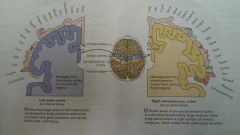
|
|
|
|
lateralization
|
localization of function
|
|
|
|
Split-Brain Surgery
|
the cutting of the corpus callosum to separate the brain's two hemispheres; used medically to treat severe epilepsy; also provides information on the function of the two hemispheres
|
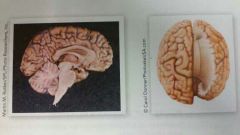
|
|
|
Corpus Callosum
|
a bundle of neural fibers that connects the brain's two hemispheres
|
|
|
|
Seretonin
|
neurotransmitters mainly involved in mood, appetite, sleep, and impulsivity
|
|
|
|
Endorphins
|
mood, pain, memory, learning, blood pressure, appetite,and sexual activity
|
|
|
|
Epinephrine
|
emotional arousal, memory storage, and metabolism of glucose necessary for energy release
|
|
|
|
GABA
|
neural inhibition in the central nervous system; tranquilizing drugs, like Valium, increase GABA's inhibitory effects and thereby decrease anxiety
|
|
|
|
Norepinephrine
|
learning, memory, dreaming, emotion, waking from sleep, eating, alertness, wakefulness, reactions to stress
|
|

